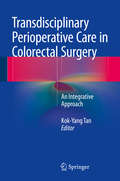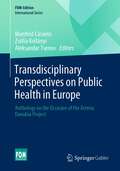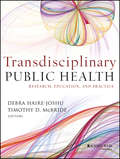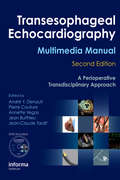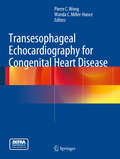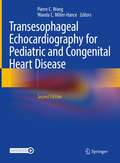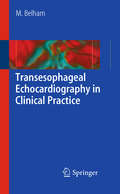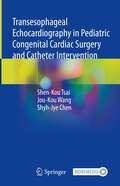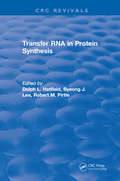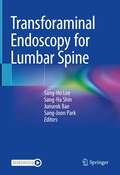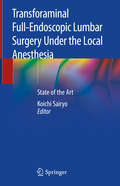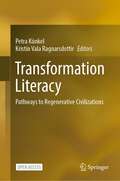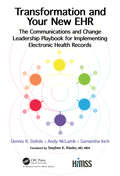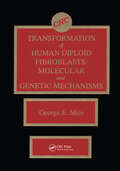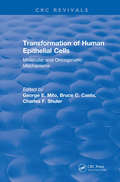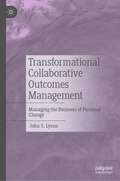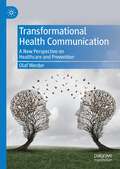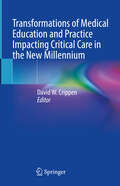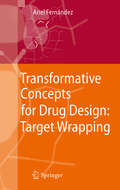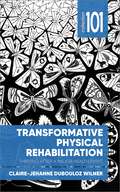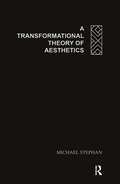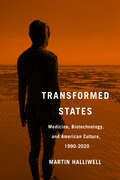- Table View
- List View
Transdisciplinary Perioperative Care in Colorectal Surgery
by Kok-Yang TanThe field of colorectal surgery has undergone tremendous developments in recent decades. Surgery has become less invasive, new perspectives and insights have improved perioperative management and novel outcome measures have been defined. At the same time, the limits of surgical technique and perioperative care are being challenged by more complex patients. In order to realize the immense potential for excellent outcomes in colorectal surgery, coordinated multifaceted care must be delivered within a context of limited resources. Accordingly, there is a pressing need to streamline processes and heighten clinical productivity. Excellent communication and collaboration are required, with constant attention to detail and precision within an environment of learning, research and innovation. This book discusses in depth the transdisciplinary integration of different components of care in colorectal surgery. Pertinent background information on the complexities of current management in colorectal surgery is first provided, followed by discussion of the role of design thinking in care integration. Subsequent chapters focus on a range of issues associated with surgical and perioperative care in patients undergoing colorectal surgery, with emphasis on how the multiple facets of care can be integrated through a transdisciplinary approach. Each chapter provides helpful take-home messages in bullet point form and numerous informative figures and tables are also included. The authors are surgeons, physicians, anesthetists, oncologists, nurses, and allied health professionals with extensive experience in the field.
Transdisciplinary Perspectives on Public Health in Europe: Anthology on the Occasion of the Arteria Danubia Project (FOM-Edition)
by Manfred Cassens Zsófia Kollányi Aleksandar TsenovIn recent decades, policymakers all over the world have sought to strengthen the meaning and effect of public, non-medical healthcare. This publication is the result of the research initiation project »Arteria Danubia ‒ Analysis and Discussion on the Implementation of Model Health Regions in the Upper and Lower Reaches of the Danube« (2017 to 2019), which focused on healthcare in Bulgaria, Germany and Hungary. In this book, researchers from the participating universities and organizations explore the topic of public health in all its facets: How can public policy and education influence people’s health? How are lifestyle-related diseases to be avoided? And how best to implement digital healthcare solutions?
Transdisciplinary Public Health
by Timothy D. Mcbride Debra Haire-Joshu"This book makes a great leap in the conceptualization of transdisciplinary approaches, as well as provides concrete examples in practice, teaching, policy, and research."-From the Foreword by Edward F. Lawlor, dean and the William E. Gordon Distinguished Professor, the Brown School; and founding director, Institute for Public Health at Washington University in St. LouisThe complexity of public health and social problems is becoming more challenging. Understanding and designing solutions for these problems requires perspectives from multiple disciplines and fields as well as cross-disciplinary research and practice teams. Transdisciplinary Public Health fills a void in the literature and offers a comprehensive text that introduces transdisciplinary methods as a means for providing an innovative tool set for problem-solving in public health research and practice.With contributions from leading experts, Transdisciplinary Public Health offers an understanding of interactions among the biological, behavioral, social, and public health sciences; shared disciplinary frameworks in analyzing health problems; and the integration and evaluation of transdisciplinary solutions to alleviate complex public health issues. Use of this important resource will promote transdisciplinary research and practice, resulting in novel solutions that positively impact human health.
Transesophageal Echocardiography Multimedia Manual: A Perioperative Transdisciplinary Approach
by Annette Vegas Pierre Couture Jean-Claude Tardif Jean Buithieu André Y. DenaultThis second edition of the Transesophageal Echocardiography Multimedia Manual is a comprehensive resource and essential guide to the rapidly expanding field of perioperative transesophageal echocardiography (TEE), encompassing newer cardiac surgery techniques, more diverse surgical procedures, and use in the intensive care unit. With over 900 figur
Transesophageal Echocardiography for Congenital Heart Disease
by Wanda C. Miller-Hance Pierre C. WongTransesophageal Echocardiography for Congenital Heart Disease represents a unique contribution as the only contemporary reference to focus exclusively on the clinical applications of transesophageal echocardiography (TEE) in congenital heart disease (CHD). Written by numerous prominent specialists and renowned leaders in the field, it presents a comprehensive, modern, and integrated review of the subject in light of the cumulative experience and most recent advances in the technology. Topics related to CHD include: (1) physics and instrumentation of TEE, particularly as they apply to the structural evaluation; (2) specialized aspects of the examination, with emphases on technical considerations pertinent to both pediatric and adult patients with congenital cardiovascular pathology; (3) segmental approach to diagnosis and functional assessment; (4) extensive discussion of the TEE evaluation of the many anomalies encompassing the CHD spectrum; (5) use of the imaging modality in the perioperative and interventional settings; and (6) important aspects of 3D TEE evaluation. Richly illustrated by more than 700 figures/illustrations and 400 videos, this textbook will serve as an indispensable resource for all who use TEE in the care of both children and adults with CHD, from the novice to the expert.
Transesophageal Echocardiography for Pediatric and Congenital Heart Disease
by Wanda C. Miller-Hance Pierre C. WongThis extensively revised textbook reviews the use of transesophageal echocardiography (TEE) in pediatric and young adult patients with cardiac disease. It reviews how TEE has made a vital contribution to these patients’ successful and continually improving clinical outcomes, enabling them to live well into adulthood. The book details the evolving technology and applications of TEE (including three-dimensional TEE), describing how this imaging approach remains at the forefront of clinical practice for pediatric patients and those with congenital heart disease (CHD). Transesophageal Echocardiography for Pediatric and Congenital Heart Disease represents a unique contribution as the only contemporary text to focus exclusively on the clinical application of TEE in children and all patients with CHD. Written by numerous prominent specialists in the field, it presents a comprehensive, modern and integrated review of the subject. Specific chapter topics include the physics and instrumentation of TEE, structural and functional evaluation, and specialized aspects of the examination, with emphasis on the technical considerations pertinent to both pediatric and adult patients with a variety of congenital and acquired cardiovascular pathologies. Consequently, it serves as a comprehensive reference for the TEE evaluation of CHD, utilizing the segmental approach to diagnosis and discussing the TEE evaluation of the many anomalies encompassing the CHD spectrum. In addition, numerous other relevant topics are discussed, including application of TEE for perioperative and interventional settings. The book is richly illustrated, with many chapters supplemented by illustrative case studies and accompanying videos. A specific section with multiple-choice questions and answers is provided at the end of each chapter to reinforce key concepts. This textbook therefore provides an invaluable and indispensable resource for all trainees and practitioners using TEE in the management of CHD and pediatric patients.
Transesophageal Echocardiography in Clinical Practice
by Mark BelhamOver the last 30 years the technological advances in TEE have been exponential and have been reflected by its increasing utilization. Currently almost all echocardiography labs undertake TEE and the vast majority of valve operations are performed with TEE guidance. When imaging a patient's heart the number of modalities available to choose from seems to be ever increasing and the clinician needs to be aware of the strengths and weaknesses of each modality in order to best answer the question posed. Those in cardiac imaging know that the spatial and temporal resolution of the modality is unsurpassed and that it is relatively easy to get good images with minimal training. The purpose of this book is thus to give practical guidance to those undertaking training in the art of TEE. It is not an exhaustive text to be used for reference but one that should be used in conjunction with hands-on experience. If used correctly it will help in realizing the true potential of TEE.
Transesophageal Echocardiography in Pediatric Congenital Cardiac Surgery and Catheter Intervention
by Shen-Kou Tsai Jou-Kou Wang Shyh-Jye ChenThis book reviews the history and evolution of intraoperative transesophageal echocardiography (TEE) as applied in various pediatric congenital heart surgeries, catheter intervention procedures and hybrid surgeries. The development of the pediatric TEE is described, including safety and efficacy data in infants and neonates. Practical insights of the use of TEE in cardiac surgery and catheter intervention are highlighted through actual case presentations with images and illustrations. Topics covered include TEE monitoring from pre-procedural planning, real-time assist during the surgery, confirmation of the intended results, as well as identification of residual lesions that require further surgical correction. This book will be a valuable resource for practitioners working in the field of pediatric congenital heart diseases surgery and interventional procedures where TEE plays a vital role.
Transfer RNA in Protein Synthesis
by Dolph L. HatfieldTransfer RNA in Protein Synthesis is a comprehensive volume focusing on important aspects of codon usage, selection, and discrimination in the genetic code. The many different functions of tRNA and the specialized roles of the corresponding codewords in protein synthesis from initiation through termination are thoroughly discussed. Variations that occur in the initiation process, in reading the genetic code, and in the selection of codons are discussed in detail. The book also examines the role of modified nucleosides in tRNA interactions, tRNA discrimination in aminoacylation, codon discrimination in translation, and selective use of termination codons. Other topics covered include the adaptation of the tRNA population to codon usage in cells and cellular organelles, the occurence of UGA as a codon for selenocysteine in the universal genetic code, new insights into translational context effects and in codon bias, and the molecular biology of tRNA in retroviruses. The contributions of outstanding molecular biologists engaged in tRNA research and prominent investigators from other scientific disciplines, specifically retroviral research, make Transfer RNA in Protein Synthesis an essential reference work for microbiologists, biochemists, molecular biologists, geneticists, and other researchers involved in protein synthesis research.
Transforaminal Endoscopy for Lumbar Spine
by Sang-Ho Lee Junseok Bae Sang-Ha Shin Sang-Joon ParkEndoscopic spine surgery is the essence of the minimally invasive surgery technique. It’s a gradually developing field of spine surgery. Nevertheless, many doctors still have difficulties in acquiring an endoscope by themselves. This is especially true for transforaminal approach endoscopy. The editors of the book are pioneers in endoscopy and have had many interesting experiences related to transforaminal endoscopy. Since each patient has a different anatomy and disc shape, there are numerous practical techniques suitable for it, but few are specifically able to describe it. The main purpose of this book is to provide the essence of endoscopy to date, based on actual video images and practical techniques of transforaminal endoscopy accumulated over decades.
Transforaminal Full-Endoscopic Lumbar Surgery Under the Local Anesthesia: State of the Art
by Koichi SairyoThis book presents the latest devices and techniques in transforaminal full-endoscopic lumbar discectomy (TELD). This minimally invasive procedure can be used to treat various spinal conditions, such as herniated nucleus pulposus, discogenic pain, foraminal stenosis, lateral recess stenosis, and infection. The book offers an overview of TELD, and discusses discectomy, thermal annulplasty (TA) and other trending topics. It also explores the history and anatomy of transforaminal full-endoscopic lumbar surgery, complications, TELD techniques, and TELD and TA for athletes. As such the book provides a much-needed foundation for the further development of this increasingly widespread procedure. Transforaminal Full-Endoscopic Lumbar Surgery Under the Local Anesthesia is a valuable resource for orthopedic surgeons, clinical residents and medical students, alike.
Transformation Literacy: Pathways to Regenerative Civilizations
by Petra Künkel Kristin Vala RagnarsdottirThis open access book brings science and practice together and inspires a global movement towards co-creating regenerative civilizations that work for 100% of humanity and the Earth as a whole. With its conceptual foundation of the concept of transformation literacy it enhances the knowledge and capacity of decision-makers, change agents and institutional actors to steward transformations effectively across institutions, societal sectors and nations.Humanity is at crossroads. Resource depletion and exponential emissions that not only cause climate change, but endanger the health of people and planet, call for a decisive turnaround of human civilization. A new and transformative paradigm is emerging that advocates for regenerative civilizations, in which a narrative of systemic health as much as individual and collective vitality guide the interaction of socio-economic-ecological systems. Truly transformative change must go far beyond technical solutions, and instead envision what can be termed ‘a new operating system’ that helps humankind to live well within the planetary boundaries and partner with life’s evolutionary processes. This requires transformations at three different levels:· Mindsets that reconnect with a worldview in which human agency acknowledges its co-evolutionary pathways with each other and the Earth.· Political, social and economic systems that are regenerative and foster the care-taking for Earth life support systems.· Competencies to design and implement effective large-scale transformative change processes at multiple levels with multiple stakeholders.This book provides key ingredients for enhancing transformation literacy from various perspectives around the globe. It connects the emerging practice of stewarding transformative change across business, government institutions and civil society actors with the most promising scientific models and concepts that underpin human action to shape the future collectively in accordance with planetary needs.
Transformation and Your New EHR: The Communications and Change Leadership Playbook for Implementing Electronic Health Records (HIMSS Book Series)
by Andy McLamb Samantha Inch Dennis DelisleTransformation and Your New EHR offers a robust communication and change leadership approach to support electronic health record (EHR) implementations and transformation journeys. This book highlights the approach and philosophy of communication, change leadership, and systems and process design, giving readers a practical view into the successes and failures that can be experienced throughout the evolution of an EHR implementation.
Transformation of Human Diploid Fibroblasts: Molecular and Genetic Mechanisms
by George E. Milo Bruce C. CastoThis comprehensive publication draws together the important aspects of carcinogen-cell interaction. This interesting work describes the regulation of normal cell proliferation, cellular responses to carcinogen damage, the biologic consequences of cellular DNA modification, the structural and genomic changes resulting from carcinogen insult, and the possible involvement of such changes in the conversion of normal human fibroblasts to malignant cells. It presents current reviews with up-to-date literature references and provides critical information from leading investigators that is essential in understanding the biology of human cell transformation. This volume is especially useful to advanced students in genetic toxicology, molecular biologists, and all who are interested in the molecular and macromolecular changes in human cells leading to neoplasia.
Transformation of Human Epithelial Cells: Molecular and Oncogenetic Mechanisms (CRC Press Revivals)
by George E Milo Bruce C Casto Charles F ShulerThis book offers a conceptual explanation of the interrelationships that exist between the stages in the progression of initiated epithelial cells in culture compared with the diverse tissue of organs and the progression of tumors from different organ sites. The fate of the modification of adducts is discussed at the molecular level. The role that modifications in hot spots in oncogenes and supressor genes play at the molecular level and how these molecular modifications can lead to an explanation of molecular control in the formation of tumor phenotypes is also examined. Researchers in cell biology and toxicology, applied pharmacology, carcinogenesis, teratogenesis, mutagenesis, and molecular toxicology will find the book useful, interesting reading.
Transformational Collaborative Outcomes Management: Managing the Business of Personal Change
by John S. LyonsTransformational Collaborative Outcomes Management (TCOM) is a comprehensive, multi-level conceptual framework for system management and improvement. This book provides a comprehensive understanding of TCOM by using person-centered, collaborative processes for decision making.The issue with current human services systems is that there is a lack of access to care and that the system is focused on providing services as cheaply as possible. TCOM focuses on helping the greatest number of people while maximizing effectiveness. By fully understanding the nature of the business of helping, the author seeks to offer ways to create and sustain effective and positively evolving helping systems. He lays out a series of goal-directed social change processes which allow people at every level of a system to begin a shift towards transformational practice and the emergence of transformational systems.Building on three decades of work in a large community of scholars and practitioners, this book will represent the first full description of the conceptual framework and will appeal to an interdisciplinary group of scholars across nonprofit management, healthcare management, and social work.
Transformational Health Communication: A New Perspective on Healthcare and Prevention
by Olaf WerderThis book advances our understanding of communicative relationships and key barriers to more effective health communication. In this, it offers a humanistic orientation of health communication as well as its social, cultural, political, ethical, and spiritual dimensions and contexts. The book therefore brings a more inclusive and integrated approach to the major challenges and opportunities in contemporary health, medicine, and wellbeing.
Transformational Leadership In Nursing: From Expert Clinician To Influential Leader
by Elaine S. Marshall Marion BroomeProvides invaluable guidance for nursing graduate students to develop the skills necessary to transform healthcare through leadership within complex healthcare settings. The award-winning Transformational Leadership in Nursing: From Expert Clinician to Influential Leader guides nursing graduate students and professionals in the development of skills required to fulfill emerging leadership roles in our increasingly complex healthcare system. It provides a wealth of critical information, practical tools, creative vision, and inspiration to help facilitate leadership in a wide variety of settings. This expanded and updated third edition presents current challenges in healthcare and frameworks for becoming a transformational leader during times of change. Expert leaders discuss the tenets of collaborative leadership―networks, influence, and decision-making―as well as the creation of organizational environments and cultures to support practice excellence. The text will help readers master the skills necessary to work effectively across disciplines and generations; develop and implement strategic plans; design, implement, and evaluate practice models; build cohesive and effective teams; and lead across systems of care to resolve healthcare disparities and improve outcomes. This inspirational text fulfills the DNP Core Competencies, as described in the American Association of Colleges of Nursing (AACN) Essentials of Doctoral Education for Advanced Nursing Practice. New to This Edition: Outlines key leadership competencies for effective leadership in complex organizations Expands the scope of the healthcare economics and finance section to address the monetization of nursing innovations; expands coverage of population health strategies Features Leadership in Action vignettes and reflective questions to help students apply theoretical concepts to their own situations Includes updated tools, healthcare paradigms, and leadership inspiration Presents cases and reflective questions to help students apply the theoretical content to their own situations and generate discussion across cohorts of students Key Features/Benefits: Written expressly for APRNs transitioning into leadership roles Traces the trajectory from expert clinician to the role of leader in complex organizations and patient populations Utilizes Leadership in Action vignettes to highlight real-world application of concepts and strategies Provides learning objectives, reflection questions, inspirational quotations from noted leaders, and resources for further learning Includes ancillary PowerPoint slides Purchase includes digital access for use on most mobile devices or computers
Transformations of Medical Education and Practice Impacting Critical Care in the New Millennium
by David W. CrippenThere have been major changes in the Education of critical care providers in recent years. Some of these changes involve the psychology of “Generation Z” applicants, new technological training aids, the issue of training disadvantaged trainees, exploring the difference between diversity and equity as well as the rise of physician extenders, physician assistants and registered nurse practitioners. Many of these changes have a direct effect on the quality and quantity of new physicians entering the work force in the new millennium. Accordingly, these Emerging Issues will have a direct impact on how critical care trainees are selected and trained, directly affecting patient care. This Volume is structured To Illustrate three platforms, each resting on the platform below. The three main sections include medical education, Including The culture of medicine and critical care medicine in the new millennium. The first section includes Examinations of “Generation Z” and medical education, evolution of resident house staff, implications for onerous medical training costs, simulation models in medical education versus direct patient care, emerging providers in medical ethics and futuristic concepts for innovative medical education. The second section details politics, internet and social media use, the future of malpractice issues in health care, metabolic investigations at point-of-care, hope versus experience in long term ICU care and anti-vaxxers in the pandemic era. The final section details triage and ICU care of critically ill patients, algorithms that might replace clinical intuition, risks and benefits of artificial intelligence, music and the brain, ICU care during global pandemics, the rise of physician extenders, probability theory in interpreting clinical outcomes, new ideas in death by neurologic criteria as well as the future of death. Written by experts in the field, Transformations of Medical Education and Practice Impacting Critical Care in the New Millennium serves as a detailed guide for seasoned clinicians working to teach the new generation of critical care physicians.
Transformative Concepts for Drug Design: Target Wrapping
by Ariel FernandezIn spite of the enticing promises of the post-genomic era, the pharmaceutical world is in a state of disarray. Drug discovery seems now riskier and more uncertain than ever. Thus, projects get routinely terminated in mid-stage clinical trials, new targets are getting harder to find, and successful therapeutic agents are often recalled as unanticipated side effects are discovered. Exploiting the huge output of genomic studies to make safer drugs has proven to be much more difficult than anticipated. More than ever, the lead in the pharmaceutical industry depends on the ability to harness innovative research, and this type of innovation can only come from one source: fundamental knowledge. This book squarely addresses this crucial problem since it introduces fundamental discoveries in basic biomolecular research that hold potential to broaden the technological base of the pharmaceutical industry. The book takes a fresh and fundamental look at the problem of how to design an effective drug with controlled specificity. Since the novel transformative concepts are unfamiliar to most practitioners, the first part of this book explains matters very carefully starting from a fairly elementary physico-chemical level. The second part of the book is devoted to practical applications, aiming at nothing less than a paradigm shift in drug design. This book is addressed to scientists working at the cutting edge of research in the pharmaceutical industry, but the material is at the same time accessible to senior undergraduates or graduate students interested in drug discovery and molecular design.
Transformative Physical Rehabilitation: Thriving After a Major Health Event (101 Collection)
by Claire-Jehanne Dubouloz WilnerDans la réadaptation physique adulte, la théorie d’apprentissage transformateur permet le développement d’un modèle détaillé du processus de transformation des perspectives de sens en réadaptation physique basé sur des indices de recherche, des exemples et des cas, et propose des conseils pour des applications cliniques. Transformative Physical Rehabilitation: Thriving After a Major Health Event s’inspire du contexte théorique et de l’apprentissage transformateur dans l’éducation des adultes (Mezirow) pour discuter du développement et du transfert des connaissances dans les interventions reliées au domaine de la réadaptation physique et communautaire. Il présente aussi les découvertes novatrices d’un projet de recherche mené pendant quinze ans sur le processus de transformation des perspectives de sens majeures avec des groupes de clients ou de patients. Ce projet a engendré le premier modèle de transformations importantes dans le champ de la réadaptation physique. Ce processus émerge de la construction de nombreuses théories substantives (Glaser & Strauss), financées à l’externe, et complétées pour la première fois auprès de populations de clients variées traités en ergothérapie, en physiothérapie et dans d’autres disciplines de réadaptation de la santé physique. Ce livre s’adresse aux cliniciens, éducateurs et étudiants en réadaptation physique, ainsi qu’à ceux qui accompagnent un proche qui traverse un important changement personnel. Publié en anglais.
Transformative Planning: How Your Healthcare Organization Can Strategize For An Uncertain Future (ACHE Management)
by Jim AustinTraditional strategic planning too often results in incremental change focused more on next year’s budget than on creative growth and sustainable development. Leadership teams struggle to “paint with two brushes”: building in transformative change while maintaining current operations. To transcend existing systems and achieve their organization’s unique vision, healthcare leaders must embrace uncertainty and incorporate flexibility into their long-term planning. They must prepare for a range of potential futures—while maintaining current operations—because agility and adaptability are what will define future success. Transformative Planning: How Your Healthcare Organization Can Strategize for an Uncertain Future explains how leadership teams can lay the groundwork for new, transformational healthcare delivery models while simultaneously meeting the requirements of today. Author Jim Austin shares the essential frameworks, tools, and processes for developing and implementing long-term strategic and execution plans that embrace uncertainty. The book’s four-step model for transformational change covers: Mental models, decision making, and decision trapsVision and strategic prioritiesStrategy development and scenario planningExecution frameworkLeadership teams and governing boards at healthcare organizations of all kinds will find Transformative Planning to be an essential guide to planning strategically for today and tomorrow.
Transformative Quality: The Emerging Revolution in Health Care Performance
by Mark HaglandAlways interesting and informed, national award-winning journalist Mark Hagland demonstrates how pioneering organizations are combining new tools with a new way of thinking to reinvent the way we deliver health care services in this country. Through exceptionally well-documented case studies, this insightful volumePuts the current journey towards
Transformatnl Theory Aesthetcs
by Michael Stephan Trevor PatemanFirst Published in 1990. How we perceive and respond to the visual image has been a traditional concern of psychologists, philosophers and art historians. Today, where the visual image increasingly permeates our everyday life and consciousness, the question becomes ever more relevant. How do we, for instance, instinctively ‘know’ what it is that a picture represents without having to be taught? How is it that we experience (aesthetic) pleasure in looking at certain pictures? How is it that we often want to talk about the pictures we look at? Such questions are currently asked by a wide range of disciplines, including: semiotics, psychoanalysis, anthropology, neuropsychology, and in general, contemporary critical analysis of the visual arts. In A Transformational Theory of Aesthetics, Michael Stephan breaks new ground by linking the findings of these areas. Drawing on their common area of knowledge, he has developed a radically new theory of picture perception and aesthetic response, arguing that images can generate in us a complex pattern of mental changes, or transformations. This is because the left and right hemispheres of the brain do not always work in harmony, hence the wide-ranging nature of aesthetic response to distinct art forms. A Transformational Theory of Aesthetics is essential reading to those seriously involved in linking the arts and cognitive sciences.
Transformed States: Medicine, Biotechnology, and American Culture, 1990–2020
by Martin HalliwellTransformed States offers a timely history of the politics, ethics, medical applications, and cultural representations of the biotechnological revolution, from the Human Genome Project to the COVID-19 pandemic. In exploring the entanglements of mental and physical health in an age of biotechnology, it views the post–Cold War 1990s as the horizon for understanding the intersection of technoscience and culture in the early twenty-first century. The book draws on original research spanning the presidencies of George H. W. Bush and Joe Biden to show how the politics of science and technology shape the medical uses of biotechnology. Some of these technologies reveal fierce ideological conflicts in the arenas of cloning, reproduction, artificial intelligence, longevity, gender affirmation, vaccination and environmental health. Interweaving politics and culture, the book illustrates how these health issues are reflected in and challenged by literary and cinematic texts, from Oryx and Crake to Annihilation, and from Gattaca to Avatar. By assessing the complex relationship between federal politics and the biomedical industry, Transformed States develops an ecological approach to public health that moves beyond tensions between state governance and private enterprise. To that end, Martin Halliwell analyzes thirty years that radically transformed American science, medicine, and policy, positioning biotechnology in dialogue with fears and fantasies about an emerging future in which health is ever more contested. Along with the two earlier books, Therapeutic Revolutions (2013) and Voices of Mental Health (2017), Transformed States is the final volume of a landmark cultural and intellectual history of mental health in the United States, journeying from the combat zones of World War II to the global emergency of COVID-19.
